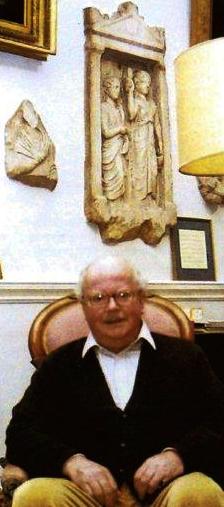I AM standing within sight of Broomhall House in central Scotland on a bitterly cold day and marvelling at how this grey, slightly dour stately home has been at the centre of one of the most heated cultural debates of modern times.
This is the house built by Thomas Bruce, the 7th Earl of Elgin, which he planned to adorn with his vast heist of Parthenon sculptures, and other antiquities that are now known as the Elgin Marbles. It amounted to some 220 tonnes and nearly half of what the Parthenon was decorated with up to the late 18th century, as well as other significant items from the Acropolis and other sites around Athens.
Broomhall House, near the village of Charlestown, Fife, is fenced off to the public, so you can’t get too close, yet even from a distance the house seems vast: a huge frontage, Grecian-style columns at the entrance, large windows, but Downton Abbey it is not!
And so I find it hard to fathom the aristocratic folly of Lord Elgin, or the hubris in wanting to hack apart some of Greece’s great cultural achievements, just to impart Grecian splendour to rural Scotland. The plan failed, as we know, yet the house has become home to some of Lord Elgin’s antiquities at least. Though which ones exactly is still a bit of a mystery.
In the late 18th century, Lord Elgin was British Ambassador to the Ottoman Empire, which ruled Greece at the time, where he got permission to remove some items from the Parthenon by using what is now considered to be a dodgy ‘firman’, official authorisation. In the end he took as much as he could, also by bribing workers on the Acropolis to help in the removal.
It was all bound for Broomhall House, and much of this was financed by his wealthy Scottish heiress wife, Mary Nisbet. What he mainly took was nearly half the frieze from the Parthenon, which depicts a religious procession, as well as some carved metopes from above the columns and 17 stunning life-sized statues from the gable ends, depicting scenes from Greek mythology. He also took a huge amount of objects, plundered from ancient Athenian burial sites and the graves of prestigious Athenians, and other Acropolis temples.
Lord Elgin arrived back in Britain in ill health, due to syphilis. He was about to be divorced by his wealthy wife, and he was also broke. He ended up having to sell the Marbles to the British Museum for £35,000, half what he wanted.
His justification for his heist was to preserve the items for posterity because the Acropolis by the 18th century had become a seedy garrison, with Turkish soldiers using the antiquities for target practice. Yet the Marbles, after being shipped from Athens, had a worse fate, being stored in a damp shed in central London for years and later said to be over-cleaned and bleached by over-zealous BM staff.
Greeks have been campaigning for years for the return of the Marbles, especially since the elite Acropolis Museum has a top floor gallery specially designed to house them in their original positions. There has also been a groundswell of international support, especially as celebrities come on board, like actor George Clooney, who made a recent plea on the subject while promoting his latest film about art theft, The Monuments Men.
And the collection of overlooked antiquities in Broomhall House would be welcome in Greece as well. These were items that Lord Elgin squirreled away here after the BM rejected them as too small, damaged or insignificant and are said to include some steles (grave markers) and pieces of sculpture. Not that you will ever see them because the house is not open to the public.
I rang the Edinburgh property management company that handles inquiries about the house, to request a comment from the current Elgin family about their collection of antiquities, and possibly as visit to the house. All the voicemail messages I left went unanswered. When I eventually tracked down a phone number for Broomhall House, I was told by a member of staff the family wouldn’t speak about the Marbles under any circumstances.
A picture taken in 1998 (above) of the current Earl of Elgin (Andrew Bruce) in his study (courtesy of Freemasonry Today magazine), shows what is believed to be a carved stele and some other items mounted on the wall. Small pickings of course compared to what Elgin looted in the early 1800s, but for Greeks these are significant items.
One local man I spoke to in the nearby village of Limekilns, who asked not to be named, has been inside the house fairly recently, in a professional capacity, and told me there are many pieces lying about.
“They are all around the house, scattered informally like bits of the furniture, but they are quite striking. The Earl of Elgin will give you the history of the items, though I can’t claim to really know their significance. His attitude to them is very relaxed and open because he doesn’t feel he has anything to hide. What he will say is that he agrees with the 7th Lord Elgin in that they were brought to Britain for preservation and that’s what he’s been brought up to think. The Elgin family are very close to the (British) Royal Family and they just have a different way of looking at things,” he said.
Tom Minogue is a crusading retiree from Dunfermline, who grew up near Broomhall House and has been researching and writing about the Marbles for a decade on his blog www.tomminogue.com which has a great deal of interesting material and a history of the Elgin Marbles.
He says: “I believe there could be a lot more of the original pieces inside the house, especially smaller pieces because there was so much material taken from Athens, like funerary urns and items taken from the graves of some of Athens’s greatest heroes.”
Certainly there are antiquities that appear to be unaccounted for. While researching this article, I came across an old library document dated 1810 with an inventory of Elgin’s “Museum” which his collection seems to have originally been called. This inventory predates the list of items presented at a Parliamentary debate in 1816 before the BM sale. Some items on the 1810 list are not in the later one, like a large sarcophagus from an Athens grave site. Also, there are some unique items on the 1816 list that are also unaccounted for, like three ancient cedar wood musical instruments, including a lute, taken from an Athens location. When I rang the BM I was told there was no record of them, or the sacrcophagus. Where are these things now?
Tom Minogue has felt so strongly about the Greek antiquities currently in Broomhall House that he took the unusual step of writing to the police in Fife and London in 2004 and again in 2009 requesting that they investigate the matter, but so far the police haven’t acted on his letters. You can read more about this on Tom’s website.
There are those who would say it’s not fair to hold the current Earl of Elgin, who fought valiantly at the Normandy landing in 1944 and recently turned 90, responsible for the sins of his forebear. However, with increasing calls for reunification of the Parthenon art works, perhaps it’s the right time for someone else in the family to engage in the argument and at least exonerate Scots from this ‘heist’.
Tom Minogue says: “Scotland’s reputation has become a byword for imperial looting and it is hoped that with the restoration of the Parthenon Marbles, the reputation of Scotland as a compassionate and fair nation would also be restored.”

A copy of part of the frieze from the original inside ‘cella’ of the Parthenon showing a religious procession
Certainly it’s a sentiment the great philhellene Lord Byron expressed in the early 19th century when he carved onto the side of the Acropolis the Latin for: “What the Goths have spared, the Scots have destroyed.”
Dr Nikolaos Chatziandreou is a Greek research scientist and cultural resource manager who also runs the very informative website www.AcropolisofAthens.gr. He spent several years studying at St Andrews University, Scotland, and is one of the main campaigners for the reunification of the Sculptures. He thinks that Scotland can play a catalytic role in this regard because the Scots can relate with the issue in yet another dimension.
He draws a poignant link between Scotland and Greece, between the historic struggle for the return of the Stone of Scone, once used for the coronation of Scottish monarchs, and the quest to reunite the pieces of the Acropolis to “restore conceptually the symbol of democracy”.
“The Acropolis sculptures are to the Greeks what the Stone of Scone is to the Scots. It is this strong historic, symbolic, emotional link between ourselves and pieces of heritage that help us define our life experience and sense of self […] Is it a coincidence the Stone of Scone is also called the Stone of Destiny? When it comes to the sculptures of the Acropolis, whose destiny should we see in them?” says Dr Chatziandreou.
The Scottish Stone of Destiny eventually went back home. What about the Marbles? I hope the guy at Limekilns isn’t right when he says the attitude of the Elgins was one of “finders, keepers”. The same could easily be said for the BM and the current British Government.
* To read a more detailed account of why the Scots are uniquely placed to lead the return of the Parthenon Sculptures, click this link http://www.acropolisofathens.gr/aoa/reuniting-the-sculptures/a-plea-for-support-from-the-scots/
For information about the new Acropolis Museum www.theacropolismuseum.gr
Books about living in Greece
For more details about my travel memoirs, Things Can Only Get Feta and Homer’s Where the Heart Is based on three years living in the Mani, southern Greece during the crisis, visit the ‘books’ page on my website www.bigfatgreekodyssey.com
Both books are available on all Amazon’s international sites and also on the Book Depository www.bookdepository.com (with free overseas postage).
To buy either of my books please click on the Amazon links below:
You can also find me on Twitter @fatgreekodyssey
And Facebook www.facebook.com/ThingsCanOnlyGetFeta
www.facebook.com/HomersWhereTheHeartIs
© Text and photographs copyright of the authors 2010 to 2019. No content/text or photographs may be copied from the blog without the prior written permission of the authors. This applies to all posts on the blog.
COMMENTS
To leave a comment on this post, please click on the bubble at the top or the “leave a reply” link below after the tags







Very interesting blog. I agree that the current Earl of Elgin’s family in Scotland could lead a charge to get the Elgin Marbles back to their rightful home – in Athens. If their family pile in Fife also contains artefacts from Ancient Greece taken by the 7th Earl, then they should also be shipped back to Greece and put on public display.
Hi Simon,
I agree that the current family could really make a gesture with the Parthenon Marbles and offer to hand what they have back to the Greeks. It would go some way to removing the negative association that Scotland has with the whole issue because of Lord Elgin being Scottish.
Thank you for sharing this excellent and very thorough article Marjory! My only grievance is that you used the British term ‘Elgin Marbles’. If you side with the Greeks who are campaigning for their return to Athens, please consider using the Greek term ‘Parthenon Marbles’ instead. It is my honour and my pleasure to reblog your wonderful post today and once again, thank you! It’s been a pleasure talking to you on Twitter 🙂
I couldn’t agree more with the thrust of your argument. Clearly the marbles and all the other stolen antiquities belong to Greece. I have always felt it was an outrage that they have never been returned. I would be perfectly happy to be able to see copies in the British Museum, The originals should go home.
Hi Jenny,
You’re quite right. The copies should be in the BM but sadly it is going to take a massive campaign of hearts and minds for the British to let go of the Parthenon Sculptures. But what a wonderful gesture it would have been to the Greek people after all they endured during the crisis.
Regards,
Marjory
Hi Effrosyni,
Yes, I agree, the term Elgin Marbles confers too much ownership on the British via Elgin. I was merely using the term that most Brits are familiar with. But even ‘Parthenon Sculptures’ is only part of the story I believe because while researching this piece I was saddened to learn how many graves around Athens were looted by Elgin as well, many belonging to distinguished citizens, and a vast amount of grave stones and other funerary items were destroyed and removed. Much of this we will never be able to trace.
It’s been a pleasure chatting with you as well.
Regards,
Marjory
Well done for the compehensive historical account on this very important issue for us Greeks.
Hi Dimitra,
Thanks for your kind comment. I will check out your other suggestion.
Regards,
Marjory
Hello from Edinburgh. 🙂
I discovered your blog by random online browsing – it has a very refined taste and a welcoming feeling. Great job!
I followed the opposite route from what you did. Moving from Nafplio to Edinburgh!
I read really carefully the whole article as it is one of the most heated cultural debates ever seen. For those who are Greek, it is even more sensitive and emotional, even though I would add that there are also more important issues and priorities we should sort out at this time. I like to think that I am not blinded with nationalism.
I really like the arguments presented in this article. They are justified, well supported and the majority of Scottish people that I have met share a similar opinion with you.
I think it would be classy for the Brits to return them, showing gratitude for the contribution and influence the Greek culture had in the world and especially in Britain (Edinburgh – Athens of the North?).
Perfidious Albion, the name that Britain is known around the world (unfortunately), was created out of narrow minded and historically arrogant attitudes like the one with the Parthenon Sculptures.
Kind Regards
Konstantinos
Hi Konstantinos,
Thanks for your kind comments. I agree with you that there are probably other important issues for Greeks to sort out right now but it would be a wonderful, generous gesture for the British to return the Sculptures soon. It would give the Greeks such a boost to their morale after the crisis they have endured. I hope you are enjoying Edinburgh and that Scotland has been good to you.
Kind regards,
Marjory
Just realised that the last part of my comment is not displayed, not sure why! Anyway, Scotland has been good and will always be good. 🙂
Would be also interesting to see what 2014 has for Scotland! Many heated debates about Scotland’s future…
Best wishes,
K
Hi Konstantinos,
Sorry the comment was shortened, for no particular reason but happy to reinstate your thoughts on Scotland in this important year with the referendum and Home Coming celebrations. Scotland and Greece are said to have a lot in common and this year shows both countries to have huge cultural/social issues to sort out. Small countries, under pressure!
Kind regards,
Marjory
Pingback: Reblogged: Scotland’s role in an Elgin Marbles mystery | Effrosyni's Blog
I can remember many years ago staying in a hotel in Limekilns where they had some copies of the elgin marbles set in a wall. I cant remember the name of the hotel alas.
Anybody know what which hotel it was?
Hi Brian,
That’s very interesting Brian. Were they small pieces and copies of the Marbles, or originals do you think? I’m guessing copies. And probably something copied from the Bruce family’s pieces at Broomhall.
I will make some inquiries. Thanks.
Regards,
Marjory